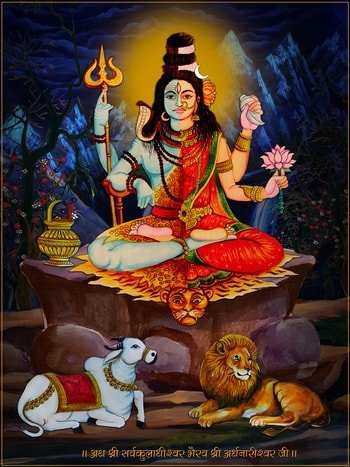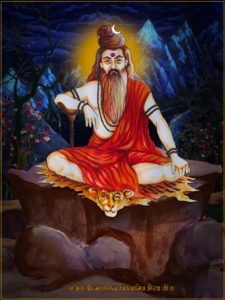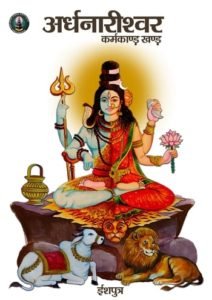Ardha Narishwara is the tantric concept and portrayal of ultimate formless God Param Shiva into two equal halves, the Shiva and the Shakti. Shiva is considered to be the masculine side while Shakti is considered to be the feminine side. Shiva is the epitome of all men while Shakti is of women.
As per “Siddha Dharma”, Ardha Narishwara is the highest concept for both male and female because it is inclusive for them both. Ardha Narishwara is the final destiny of both male and female so that they complete each other. The whole modus operandi of “Siddha Dharma”, as well as many tantric kulas, is based on the concept of Ardha Narishwara.
Iconography
As per the “Siddha Dharma”, the Ardha Narishwara is either represented in human body or in abstract symbol. As a human body, Ardha Narishwara is portrayed as the perfect body whose right side is Shiva while as the left side to be that of the Shakti. In abstract symbol, he is portrayed as “Shivling”.
The Shivling is a symbol which portrays men and women or masculinity or femininity in perfect union. In the symbol, all men and their masculinity is represented by Shiva in the form of “linga” while all the women or femininity is represented by Shakti in the form of “yoni”. As per the “Siddha Dharma”, the shivlinga is portrayed as a sexual union between male and female or linga and yoni. Sexual union in tantra doesn’t simply imply the act of physical sexual act but also oneness or non-dual. Therefore, as per “Siddha Dharma”, the Ardha Narishwara would imply the union of two opposite entity, Shiva and Shakti, masculinity and femininity.
The origin story of Ardha Narishwara
As per the “Siddha Dharma”, Brahma ji after having created the universe, he created numerous Prajapati to move the creation forward. While doing so, he also created manas putras like Maharishi Narada, Sanakadi Rishis etc. who all chose to remain celibate and not marry at all. Even the plan of Brahma ji in appointing Prajapati failed because Prajapati was a patriarchal concept. It was a male dominated society and it was the men running the society. It failed miserably.
Brahma ji saddened of the ineptness of the Prajapati, he went to lord Shiva for the solution. Lord Shiva then showed him his Ardha Narishwara form. It was a clear insinuation from lord Shiva that the creation can only go forward if both male and female work to further the creation. The society would also likely to fail if either one of them is secluded. Lord Brahma ji having understood the insinuation returned back and asked his Prajapatis to run the society where men and women were given equal importance.
As per “Siddha Dharma”, the legend has it that when Param Shiva or Parmatma decided to create the universe, he didn’t do it directly. He first created a human body which had the right side as of male body and the left side as the female body. It was Shiva and Shakti and that form is called “Ardha Narishwara”.
The philosophy of Shiva and Shakti
As per “Siddha Dharma”, tantra is based on the concept of Shiva and Shakti. Shiva implies forms of masculinity while Shakti represents all forms of femininity. Shiva is the also the idea of a perfect man or Shakti is the idea of perfect women.
Shiva by nature is passive because he is always portrayed in meditation. He also represents metaphysics or beyond physical. He is also a minimalist with almost no possessions at all. He represents “sanghara” or annihilation. The annihilation means the annihilation of everything in this universe so that only eternity remains and in the case of human, the only eternal thing is existence or the soul. Shiva is more eternity oriented, beyond forms, dispassionate while Shakti represents “Shristi” or creation aspect. Shakti is more creation oriented and also maintains the universe because Shakti as in the form of Matrika can reproduce and foster the creation as her children. Shiva doesn’t foster the creation but Shakti does.
As per “Siddha Dharma”, both Shiva and Shakti are binary opposite and are equal because they have no individual existence of their own. One cannot be interpreted without the help of another. Shiva is incomplete without Shakti because Shiva is defined in the terms of Shakti while Shakti is defined in the terms of Shiva. For instance, day and night is inseparable part of each other. Day only has importance because there is night eventually and night has relevance because day would come eventually.
In “Siddha Dharma”, just because Shiva and Shakti are binary opposite doesn’t mean that one is favored then another unlike that of western concept of binary opposite. In fact, Shiva and Shakti are so equal that none can be favored more or less and none can be treated subordinate of each other.
Shiva and Shakti and different forms of sexes
As per “Siddha Dharma”, Shiva is the ultimate male while Shakti is ultimate female. The distinction is based on spiritual concept and not based on biology alone or on gender. Gender is a social, economic, legal interpretation of male and female but Shiva and Shakti is an inclusive concept which also represents men and women as biological sexes as well as spiritual interpretation about various interpretations related to ultimate men and women.
Our Indian society had no place for the modern day concept of gender because in today’s day and age, the interpretation is done based on socio-economic factors. In ancient society, especially the Indian society, the sole style of interpretation was all based on spiritualism. Therefore, our society never had discrimination against women because women were worshipped. It was only before few millenniums that everything started to become taboo because people stopped following the teachings of the great sages.
All together the Himalayan Siddhas listed five different sexes.
1) Stri (woman)
2) Purusha (man)
3) Napunsaka (Eunuch)
4) Ubhayalingi (Transcendental sex)
5) Nirlingi (Sexless)
Male and female attributes
As per “Siddha Dharma”, Shiva represents ultimate male attributes while Shakti represents female attributes. Shiva is all powerful and all-pervading but is passive. The male attributes is therefore someone who is powerful and all engaging but is passive because of dispassion. Freedom is more preferable to male then bondage. Shakti represents female attributes. Attributes like arts, compassion, desires, and aesthetics are all female attributes.
Spiritualism is the attribute of Shiva while creativity, aesthetics, abundance is the female virtues. Therefore, Ardha Narishwara is the balance between male and female virtues and attributes. A perfect person who has both virtues balanced.
Shiva, Shakti and Kundalini
As per “Siddha Dharma”, the Kundalini is a tantric concept of inner shakti while the consciousness is the Shiva. We all have seven important chakras in our body. The base chakra is the mooladhar chakra which lies in the area between the genitals and the anus. It is that base chakra where kundalini in the form of shakti resides. The mooladhar chakra is the chakra that connects a human body with the world. The chakra is mainly responsible for reproduction and creation (shristi). Shakti is the epitome of creation therefore it is through that shakti, humans are able to reproduce.
As per “Siddha Dharma”, just like in the outer universe, there are seven lokas above the Prithvi loka. Similarly, the mooladhar chakra which is the epitome of “prithvi tatwa” has altogether seven chakras above it including itself. Just like a siddha, transcends one loka to another and ultimately rests upon satya loka, similarly the kundalini shakti transcends each chakra and reaches the satya loka inside a human body, i.e. Sahastrahar chakra or crown chakra. In the sahastrahar chakra, Shiva passively sits there witnessing shakti and everything except himself exactly like lord Shiva being seated on a top of Mount Kailash and being witness to the creation and his shakti, Parvati.
As per “Siddha Dharma”, the whole dichotomy between Shiva and Shakti and the kundalini shakti can be explained through the analogy of a lotus plant. The lotus plant blooms in the mud such that its roots are under the water but the petals are above the water, facing the sun. To explain the analogy, the water is the manushya loka, the mud inside the water is the prithvi or soil. The stem of the lotus plant is the backbone or spine.
Just like a lotus extracts all its survival ingredients from the mud through its stem, similarly we humans also extract those vital ingredients from the world to survive. The lotus plant in its top has lotus petals which correspond to the 1000 petal lotus called sahastrahar chakra. In the tip of the lotus plant lies the pollen grains which is the Shiva. The whole lotus plant starts from mud and ends in pollen grains. Our human body is similar too as it starts from Shakti and ends in Shiva.
Therefore, as per “Siddha Dharma”, the Ardha Narishwara means the fertilization of pollen grains in the lotus plant while in human body; it’s the unification of Shakti and Shiva in sahastrahar chakra.
Bhairava and Bhairavi
As per “Siddha Dharma”, the word “Bhairava” denotes all male tantra practitioners while “Bhairavi” denotes all female practitioners. Bhairava is mini Shiva and Bhairavi is the mini Shakti. Bhairava/Bhairavi are the defacto Shiva/Shakti in its fledgling state. A fledgling swan one day becomes a fully grown swan. Bhairava/Bhairavi are like those fledglings who someday shall transform themselves into Shiva and Shakti. The purpose or the end of all Bhairava/Bhairavi is to transform themselves into Shiva and Shakti.
As per “Siddha Dharma”, lord Shiva while explaining agama-nigama to Shakti, addresses each other as Bhairava and Bhairavi because tantra is a pragmatic technique. When it boils down to practice Shiva and Shakti transforms into Bhairava and Bhairavi for practicing the tantra. For instance,
When Ma Aghoreshwori Kurukulla Parvati had conversation about vaam and tamas marga with Swachhanda Shiva as per agama-nigama talks, they transformed themselves into Kaal Bhairava and Kaal Ratri and descended to a cemetery to practice the tantra and out of which Vajra Yogini originated.
Kula and Akula
As per “Siddha Dharma”, Kula and Akula are two similar words which correspond to Shakti and Shiva. Kula means family. Tantra is always practiced in family. In Himalaya, there used to be more than 1000 kulas but now only 250 active kulas remain and it is also rapidly declining. The Kaula kula is one of the best among the kulas. Kaula kula means the family of Kaulas. The head of Kaula Kula is Ma Aghoreshwori Kurukulla. The Kaula kula means the family or kula of Kurukulla. Furthermore, the word kula also originated from Kurukulla herself. Kaula kula is all about tantra based on the kula of Kurukulla. The modus operandi of any kula is based on the head of that particular kula. The head of Kaula kula is Sukulla, Kurukulla or Vikulla (the three forms of Kurukulla). If the head of the kula is Sukulla, the modus operandi or the tantra is satwik dominated, if Kurukulla then rajas dominated and if Vikulla then its tamas dominated. The Kundalini Shakti is also taken as kula therefore, the agama-nigama mentions kundalini as kula kundalini.
As per “Siddha Dharma”, Akula means beyond kula. Shiva is Akula as Shiva has no family. Shiva is beyond all family, beyond all modus operandi of tantra, beyond all gunas. He is neither satwik, rajasic nor tamasic as he embodies all those three gunas and he transcends them all. He has transcended everything in this universe therefore he is portrayed on a mountain top or inside the head of the human body while kula is portrayed in mooladhar chakra and kula tantra is practiced in society and not in mountain top. Akulavira Tantra mentions that kula is the path to creation while the Akula is the path that leads to moksha. Shiva is the epitome of moksha.
Kula and Gotra system
As per “Siddha Dharma”, the Indian sub-continent basically had two systems of lineages, the Kula system and the Gotra system. The kula system is based on family lineage and that is related to Shakti or Devi. Some have kula devta but it is the same thing because there is always a female shakti of every male god. The kula devta means the family god/goddess under which the ancestors practiced tantra. For instance, if a person’s kul devi is Mahakali then the person’s ancestors were the tantra practitioner of Kaula kula because Mahakali is the head of Kaula kula.
The gotra system is not based on family but individuals or Shiva. Gotra is a form of Akula. The Sapta Rishis are also Shiva because they have transcended everything in this universe. Many people may have the same gotra but different kulas because all kulas merges into gotra. Within one gotra system, there are many kulas. For instance, if a person’s kula devi is Mahakali and gotra is Bharadwaj, the head of the kula of that person is Maharishi Bharadwaja but the dominant goddess is Mahakali. It in a way also means that one worships Mahakali to trace their roots to Bharadwaja Rishi and become like him.
Ardha Narishwara and Marriage
As per “Siddha Dharma”, Ardha Narishwara means Shiva and Shakti have merged into one such that the left part is portrayed as Shiva while the right part is portrayed as Shiva. Even lord Shiva treats Mata Shakti as his vaam anga (left part) of the body. Therefore, vaam marg is the path of Shakti, the joint path of bhoga and moksha.
In traditional Hindu marriage, the bride is kept at the left side of the bride groom. The bride groom is placed at the right side of the bride. This implies that the bride is in the process of being one with the bride groom and vice versa. The bride after the conclusion of the marriage becomes the vaam anga (left part of the body) of the bride groom while the bride groom becomes the right part of her body.
As per “Siddha Dharma”, the whole tantra modus operandi behind the marriage system is the concept of Shiva and Shakti or the Ardha Narishwara. Marriage in our society was neither a sexual contract theory like western feminism believes nor devolvement of rights of woman. It was more spiritual in nature such that man and woman unite and work together to achieve common aspirations and ultimately achieve spiritual union and perfection.
Ardha Narishwara and Siddha Dharma
The base philosophy of “Siddha Dharma” is rooted in the concept of “Ardha Narishwara”, the notion that Shiva and Shakti are one and the path of Shakti also means the perfection of the path of Shiva while the path of Shiva is also the perfection of the path of Shakti. Therefore, the highest symbol of “Siddha Dharma” is the Shiva ling which denotes the union of Shiva and Shakti.
Ardha Narishwara and Mahavidya
As per “Siddha Dharma”, the whole tantra of the ten mahavidhya is also based on the concept of “Ardha Narishwara”. The mahavidhyas are the goddesses who bestow anything to her worshipper but the main aim of any mahavidhya is to be the Shiva. It is through the path of mahavidhya the practitioner becomes the corresponding Shiva. For instance,
If a person pursue Matangi Mahavidhya then the whole point of pursuing Matangi mahavidhya is to perfect both left and right brain along with other art forms but the ultimate end or the purpose of Matangi mahavidya is to become Matang Shiva. The whole concept of Matangi mahavidya boils down to Matang Shiva.
Shiva and Shakti as Prakriti and Purusha
As per “Siddha Dharma”, the magnum opus of Mahasiddha Kapila is the “Samkhya” darshana which explains mainly the relationship between Prakriti and Purusha. Prakriti is everything empirical and material while Purusha is the nucleus around which Prakriti revolves itself.
Prakriti is everything in this universe. She is nearly infinite yet she has a nucleus around which she revolves. That nucleus is the passive while Prakriti is active. In fact, it is Prakriti that has pragmatic value because Prakriti is the cause for all while Purusha remains hidden. But for the Prakriti to cause anything, she needs Purusha. The whole essence of Prakriti creating the universe is like spider creating its cobweb because that is the nature of the spider while being a witness is the nature of Purusha.
Furthermore, the Prakriti being nearly infinite has a nucleus that is roughly the size of a thumb. For instance, if you consider the infinite universe, the Purusha being a thumb sized means that Purusha is proportionally less than Prakriti, yet is the highest truth in the universe.
The guru-disciple tradition of Ardha Narishwara
The Siddha Dharma believes that the main guru of “Ardha Narishwara” is Mahasiddha Nandi Nath. It was Nandi Nath who initiated sapta rishis, different maharishis to the wisdom of “Ardha Narishwara”. Some prominent siddha personalities like Maharishi Vishwamitra, Mahasiddha Matsyendra Nath played very instrumental role in propagating the wisdom forward.
After Mahasiddha Nandi Nath had introduced “Ardha Narishwar” wisdom into Kaula Siddha tradition, it was Mahasiddha Matsyendra Nath who revived this wisdom later. The modern day “Ardha Narishwara” wisdom is based on the teachings of Mahasiddha Matsyendra Nath ji. From him, it got infused in Kaula Siddha lineage and through the lineage, His Holiness Mahasiddha Ishaputra received the initiation.




